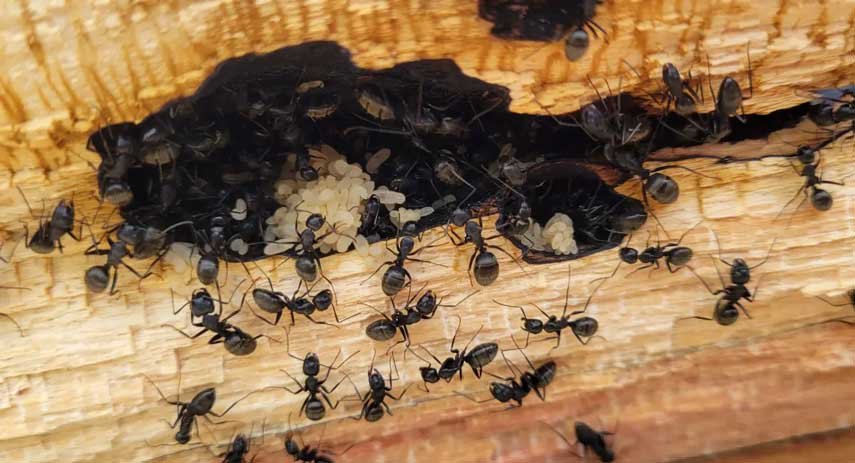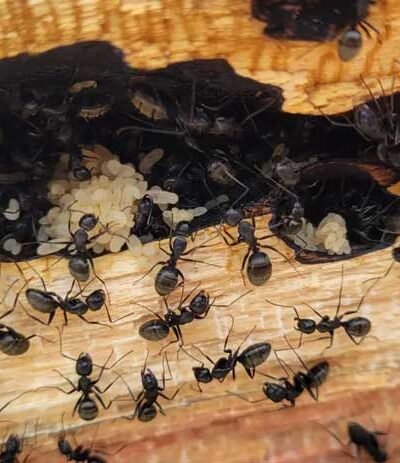 Carpenter ants are a significant concern for homeowners in Alaska. These destructive pests can compromise the structural integrity of homes, burrowing into wooden beams, walls, and foundations. Unlike termites, carpenter ants do not consume wood; instead, they excavate tunnels to establish their colonies. This blog will explore how to identify a carpenter ant infestation, understand their behavior, and implement effective carpenter ant control methods to protect your Alaskan home.
Carpenter ants are a significant concern for homeowners in Alaska. These destructive pests can compromise the structural integrity of homes, burrowing into wooden beams, walls, and foundations. Unlike termites, carpenter ants do not consume wood; instead, they excavate tunnels to establish their colonies. This blog will explore how to identify a carpenter ant infestation, understand their behavior, and implement effective carpenter ant control methods to protect your Alaskan home.
Understanding Carpenter Ants
Carpenter ants (Camponotus spp.) are one of the largest ant species in North America. They play a vital role in breaking down decayed wood in forests, but when they enter homes, they become a costly nuisance.
Characteristics of Carpenter Ants
- Size:Ranges from ¼ to ½ inch, with some queens growing up to ¾ inch.
- Color:Typically black, but some species have reddish or brownish hues.
- Wings:Reproductive ants (alates) have wings and often emerge in spring or early summer.
- Mandibles:Large, powerful jaws capable of excavating wood.
Signs of a Carpenter Ant Infestation
Carpenter ants are often mistaken for termites, but there are distinct signs that indicate their presence:
- Sawdust-like Frass:As carpenter ants tunnel through wood, they push out sawdust-like material called frass, which consists of wood shavings and insect body parts.
- Rustling Noises:Homeowners may hear faint rustling sounds within walls, especially at night when ants are most active.
- Large Ants Indoors:Spotting large black ants inside your home, particularly near moisture-damaged wood, is a strong indication of an infestation.
- Hollowed Wood:If wood sounds hollow when tapped, it may be a sign of carpenter ant damage.
- Swarmers:Seeing winged ants inside your home, particularly near windows, signals a mature colony seeking to establish a new nest.
Why Are Carpenter Ants a Problem in Alaskan Homes?
Alaska’s cold climate means homeowners must insulate their houses well, but this also creates ideal conditions for carpenter ants to nest inside warm, moisture-laden wood. The following factors contribute to infestations in Alaskan homes:
- High Moisture Levels:Carpenter ants prefer damp, rotting wood found near leaks, condensation, or poorly ventilated crawl spaces.
- Long Winters:Indoor heating attracts carpenter ants, encouraging them to nest in wall voids, attics, or basements.
- Wooded Environments:Many Alaskan homes are surrounded by forests, providing a natural habitat for carpenter ants.
Carpenter Ant Control: How to Protect Your Home
- Prevention Strategies
The best way to deal with carpenter ants is to prevent them from entering your home in the first place. Here are some effective measures:
- Eliminate Moisture Sources:Repair roof leaks, plumbing issues, and condensation problems that create damp conditions attractive to ants.
- Seal Entry Points:Use caulk or weatherstripping to close gaps around windows, doors, utility pipes, and foundation cracks.
- Trim Vegetation:Trim tree branches and shrubs away from your home to prevent ants from getting in.
- Store Firewood Properly:Keep firewood at least 20 feet away from your house and elevated off the ground.
- Reduce Clutter:Eliminate wood debris and unused lumber from your yard, as they provide nesting sites.
- Identifying and Eliminating Carpenter Ant Nests
Carpenter ants establish primary nests in decaying wood and satellite nests in dry, indoor spaces. Locating the nest is crucial for effective carpenter ant control.
How to Find the Nest:
- Follow the ants’ movement, particularly in the evening, when they are most active.
- Look for frass piles around baseboards, window sills, or under damaged wood.
- Tap on wooden surfaces; if you hear a rustling noise, you may have found a nest.
Destroying the Nest:
- Direct Insecticide Application:If you locate the nest, apply a carpenter ant insecticide spray or dust directly into the tunnels.
- Diatomaceous Earth:A non-toxic, natural alternative that dehydrates and kills ants when sprinkled in affected areas.
- Baiting:Ant baits with slow-acting insecticides are effective in killing entire colonies, as worker ants carry the poison back to the nest.
- Professional Carpenter Ant Control Services
If an infestation is severe or nests are hidden within structural elements, professional pest control is the best option. Experts can:
- Conduct a thorough inspection using moisture meters and infrared cameras.
- Apply specialized insecticides that penetrate deep into wooden structures.
- Provide long-term prevention plans to protect your home.
- Natural Remedies for Carpenter Ant Control
If you prefer eco-friendly methods, consider these natural remedies:
- Borax and Sugar Bait:Mix borax with sugar and water to create a bait that disrupts the ants’ digestive system.
- Essential Oils:Peppermint, tea tree, and citrus oils act as natural repellents when sprayed around entry points.
- Vinegar Solution:A mix of white vinegar and water can disrupt ant trails and deter foraging ants.
How to Tell If Carpenter Ants Are Gone
After implementing carpenter ant control measures, monitor your home for the following signs of success:
- No Visible Ants:If you no longer see carpenter ants indoors, the infestation may be resolved.
- No More Frass:A lack of new sawdust piles indicates reduced activity.
- Silence in Walls:If you no longer hear rustling sounds, the nest may be inactive.
Protecting Your Alaskan Home
Carpenter ants are a persistent problem in Alaskan homes, but with proper carpenter ant control, homeowners can prevent and eliminate infestations. Regular inspections, moisture management, and proactive pest control strategies are key to maintaining a structurally sound home.
If you suspect a carpenter ant infestation in your home, act quickly. Whether you choose DIY methods or professional extermination, taking early action can prevent costly damage and keep your home safe for years to come.




Leave a Reply